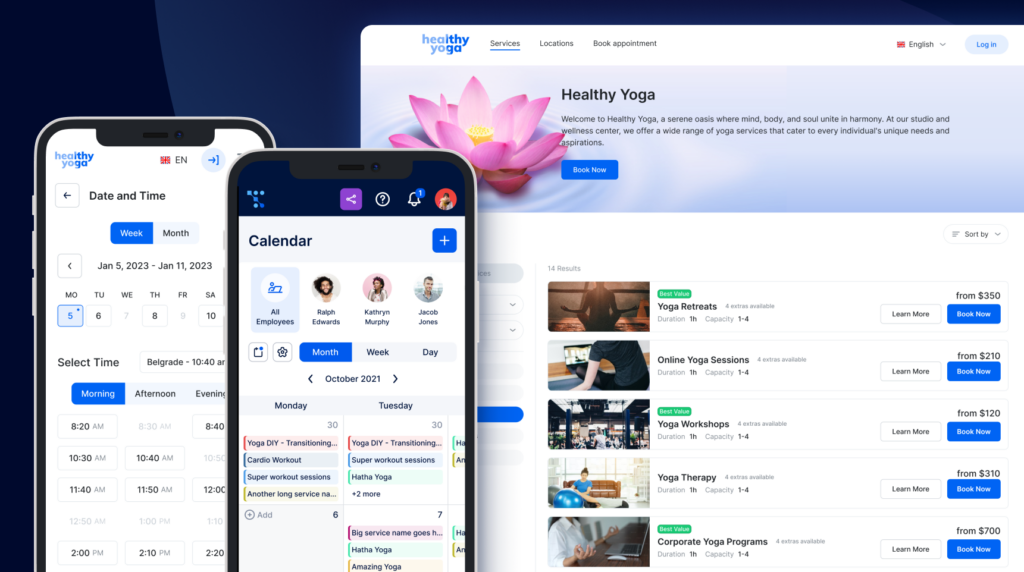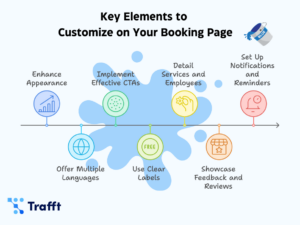Running a service-based business is a bit like playing chess with your schedule – every move counts. But, just when you think you’ve got the perfect strategy, scheduling conflicts sneak onto the board, ready to disrupt your game.
Staying ahead, or let’s call it staying one step ahead, of these curveballs is your ticket to victory in this scheduling chess match.
And that’s why we’ve crafted this ultimate guide to scheduling conflicts – dive into the common causes of scheduling conflicts and learn how to identify and avoid them before they disrupt your schedule.
Let’s start!
What is a Scheduling Conflict?
A scheduling conflict occurs when two or more commitments overlap in your planned timeline. This happens when your scheduled appointments, client meetings, or employee shifts collide, causing a disruption in your day-to-day operations.
For service business owners, scheduling conflicts can range from double-booked appointments to unexpected overlaps, throwing a curveball into your carefully arranged schedule.
Essentially, a scheduling conflict is a clash between what you’ve planned and what unfolds in reality. This clash can have potential ripple effects on your business operations and result in inefficiencies, frustrated clients, and challenges in maintaining a smooth business flow.
12 Common Causes of Scheduling Conflicts: Examples & Tips to Avoid Them
There are 12 common causes of scheduling conflicts, and they are:
- Forgetfulness
- Clients running late
- Last-minute cancellations & no-shows
- Miscommunication
- Overlapping appointments
- Double booking
- Overbooking
- Last-minute employee callouts
- Chaotic shift trading
- Booking unavailable employees
- Different time zones
- Resource-related schedule conflicts
1. Scheduling conflict caused by forgetting about the appointment
Forgetting about an appointment is like that “oops” moment we all have – it happens when the sheer number of things on our plate makes it easy for one to slip our minds. This common scheduling mishap can lead to missed opportunities and strained relationships.
Juggling too much can make our memory play tricks on us, and in the fast-paced world of appointments, it’s easy for one to sneak away from our attention.
Example: Picture this scenario – you’ve meticulously planned a salon appointment for a high-profile client, ensuring all details align seamlessly. However, when the day comes, you realize, to your horror, that the appointment slipped your mind.
Pro Tip: To fortify your memory against such slip-ups, consider integrating booking software with automated reminders into your scheduling routine. Trafft acts as your personal timekeeper, sending timely reminders about upcoming appointments and ensuring that no commitment goes unnoticed.
2. Scheduling conflicts caused by clients running late
The punctuality of clients can impact scheduled appointments, causing delays and potentially creating a ripple effect, impacting all the appointments that follow. It’s like a chain reaction, where one late arrival sets the tone for the rest of the day.
Example: You’re running a beauty salon, and your carefully planned appointments start to unravel when a client arrives fashionably late. Suddenly, the domino effect kicks in, and your subsequent appointments get pushed back.
Pro Tip: Stay ahead of client tardiness by using a booking system with automated appointment reminders. These reminders, like the ones in Trafft, gently nudge clients to be on time, minimizing the disruption caused by late arrivals and ensuring your business operates smoothly.
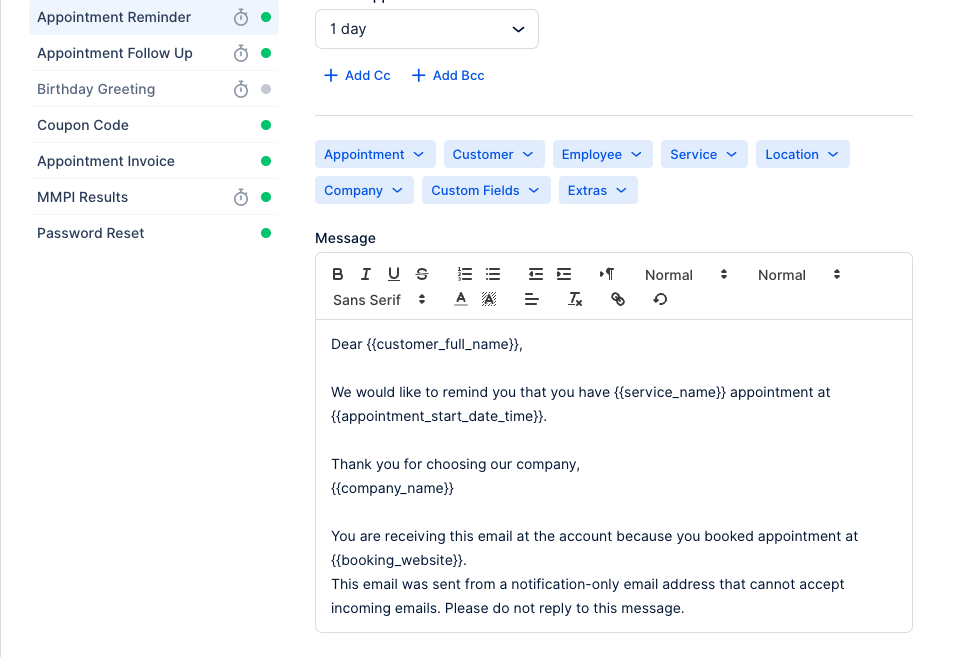
3. Scheduling conflicts caused by last-minute cancellations & no-shows
Last-minute cancellations and no-shows are when appointments or commitments are canceled abruptly or individuals fail to appear without notice. These unplanned changes can disrupt schedules and create unexpected gaps in your plans.
Example: Let’s say you run a yoga studio. A last-minute cancellation occurs when a student decides not to attend a class they had booked and notifies you moments before the class. On the other hand, a no-show happens when a student simply doesn’t show up for their scheduled class, without even letting you know. These situations can leave your yoga studio with empty spots in classes, impacting both your schedule and potential revenue.
Pro Tip: To manage the impact of last-minute cancellations and no-shows, set up a clear last-minute cancellation policy and make sure everyone knows about it. Communicate policies effectively to minimize disruptions to your schedule and ensure that your time is respected even when faced with these sudden changes.
4. Scheduling conflicts caused by miscommunication
Miscommunication in scheduling happens when people don’t quite get on the same page about agreed-upon schedules. It’s like when you and someone else have different ideas about when something’s supposed to happen. This mix-up can lead to missed appointments, frustration, and even damage your professional relationships.
Example: Let’s say you run a tutoring service, and you’ve set a time for a student’s session. If there’s a miscommunication and the student shows up at a different time, thinking the session was later, it can cause confusion and potential setbacks in your teaching schedule.
Pro Tip: Bridge the communication gap and foster clarity by incorporating appointment confirmations into your scheduling process. Trafft sends out detailed confirmations, ensuring that all parties are on the same page and minimizing the risk of misunderstandings.
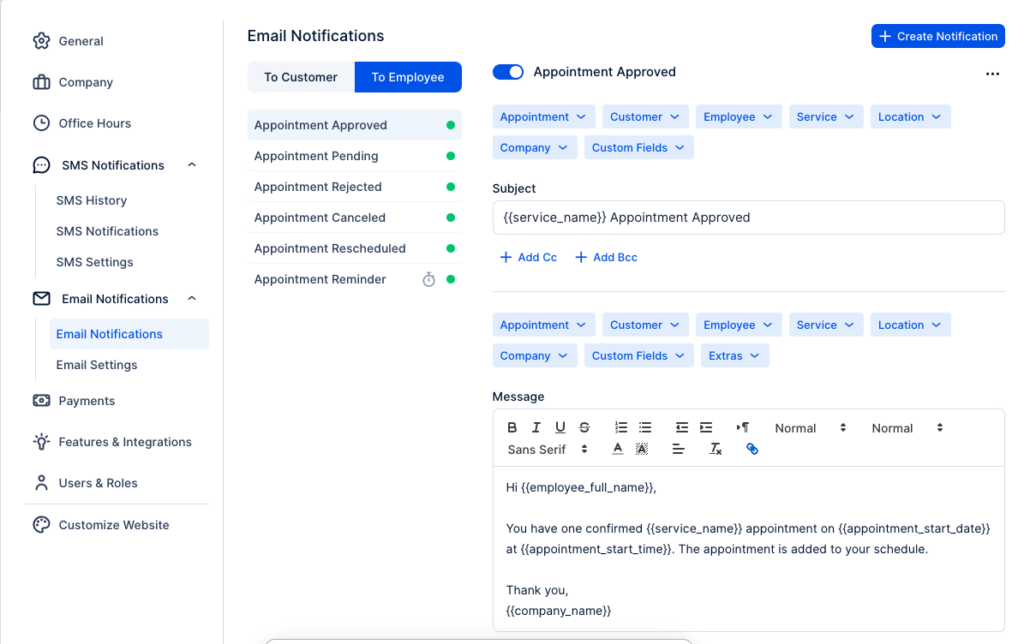
5. Scheduling conflicts caused by overlapping appointments
Overlapping happens when two services are scheduled with little breathing room between them. The end of one event precisely aligns with the beginning of the next service. It’s that moment when your appointments or tasks collide on your schedule, and you find yourself navigating through a time crunch.
Example: You’ve got Appointment One kicking off at 1:00 PM, and Appointment Two follows closely at 1:30 PM, each lasting 45 minutes. As the clock ticks, the end of the first appointment seamlessly blends into the start of the second, showcasing how overlapping commitments can create a time-juggling act in your daily schedule.
Pro Tip: Navigate the intricate dance of overlapping commitments with ease by leveraging the appointment buffer time slots feature. Trafft provides a breather between appointments, allowing you to transition seamlessly from one task to the next without the stress of overlap.
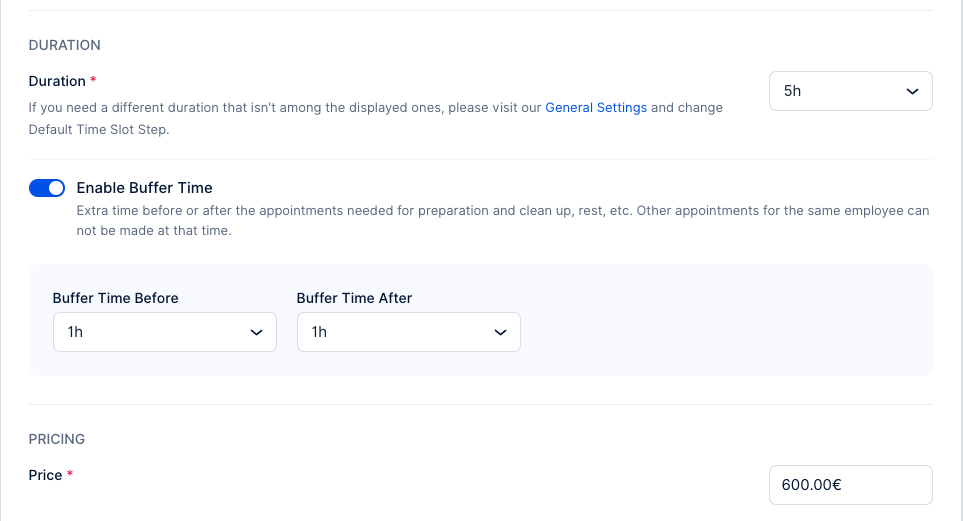
6. Scheduling conflicts caused by double booking
Double booking happens when the same time slot is assigned to two conflicting appointments or commitments. It’s a scheduling hiccup where overlapping commitments demand attention simultaneously, putting us in the tricky spot of having to pick one.
Example: Picture this – you run a catering service, and on a busy Saturday, you’ve committed to catering a wedding reception at 3 PM, while completely forgetting you already committed to providing refreshments for a corporate event the same day, the same time. Cue the dilemma.
Pro Tip: Navigate the tightrope of conflicting commitments with ease by using scheduling software with calendar synchronization features. One of many scheduling hacks that Trafft has is seamless tracking and management of all your appointments, across all of your calendars, ensuring you’re aware of and can confidently manage potential double bookings.
7. Scheduling conflicts caused by overbooking
Overbooking is a scheduling faux pas where you accept more commitments than your schedule can realistically handle, leaving you with a crammed and stretched-thin agenda. It’s like trying to fit too many puzzle pieces into a limited space on your schedule.
The difference between overbooking and double booking lies in the intention behind it. Overbooking is about saying “yes” to more tasks than your schedule comfortably allows, while double booking involves scheduling two things in the same time slot by accident.
Example: Let’s say you own a catering business. Overbooking in this context could be accepting multiple catering orders for the same time slot without considering the logistics. You find yourself juggling between setting up a wedding banquet and delivering corporate lunch boxes simultaneously. The result? A chaotic and stressful scenario where the quality of your catering service may be compromised due to spreading resources too thin.
Pro Tip: Avoid the overbooking trap by carefully evaluating your capacity, setting clear priorities, and utilizing tools like Trafft to streamline your schedule. This ensures each event receives the attention and dedication it deserves, maintaining the excellence of your service.
8. Scheduling conflicts caused by last-minute employee callouts
Last-minute employee callouts are the unexpected moments when a team member can’t make it to their scheduled shift, throwing a wrench into your carefully planned schedule. This can be particularly challenging for businesses that rely on shifts, like in the service industry.
Example: Imagine you run a small bakery, and one of your star bakers calls out right before the morning rush. Suddenly, your well-organized baking schedule is in disarray, and you’re left trying to find a quick solution to keep up with customer demand.
Pro Tip: Shield your schedule from the chaos of last-minute callouts by having a clear policy in place. Communicate expectations to your team, have backup plans ready, and use tools like Trafft to efficiently manage unexpected changes in employee availability by having all of your staff schedules in one place. This ensures your business continues to operate seamlessly, even in the face of unexpected hiccups.
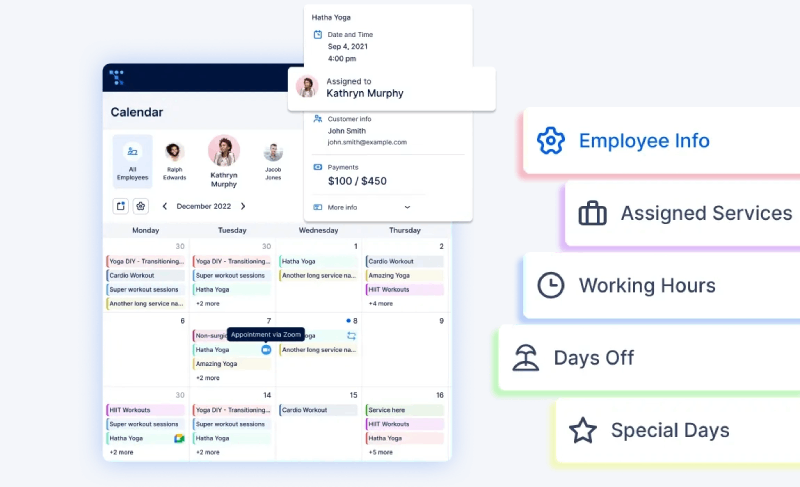
9. Scheduling conflicts caused by chaotic shift trading
Chaotic shift trading is when employees switch shifts without keeping things in check, leading to confusion, conflicts in the schedule, and just a general mess in how things usually run. In workplaces where schedules are like puzzle pieces, chaotic shift trading can throw the whole picture into chaos.
Think of it like a game of cards – employees swapping shifts like poker hands, but instead of a winning hand, you end up with a scrambled schedule. Now, this doesn’t just keep the employees involved on their toes; it also messes with the team’s overall productivity.
Example: Imagine you run a restaurant, and suddenly your chef and waiter swap shifts unexpectedly; chaos in the kitchen and at the tables is almost guaranteed.
Pro Tip: Regain control over shift scheduling and management by closely tracking and monitoring employee schedules. Trafft simplifies the process, allowing both you and your employees to monitor and manage employee schedules efficiently, preventing the domino effect of last-minute changes.
10. Scheduling conflicts caused by boking unavailable employees
Booking unavailable employees can lead to chaotic situations, especially when clients schedule appointments with staff members who are not actually available on a given day. Such booking mistakes can result in confusion and wasted time, as well as potentially harm your professional relationships with clients due to unexpected staff unavailability.
Example: A barber urgently requests a day off, and their manager approves it, but this information isn’t communicated to the rest of the team. Meanwhile, another team manager, unaware of the absence, makes it available to schedule services with the same barber. The result? Customers show up and there’s no one to cater to them.
Pro Tip: To avoid these mishaps, it’s crucial to establish clear communication channels within your team. Using a reliable scheduling tool, like Trafft, can also play a vital role in preventing booking errors. It ensures that real-time updates on staff availability are visible to all team members, minimizing the risk of clients booking appointments with employees who are not actually available on a given day.
11. Scheduling conflicts caused by different time zones
In our world where everything is connected, dealing with scheduling conflicts due to different time zones is a constant puzzle. Trying to set up meetings or appointments with people from various regions needs some extra thought to avoid mix-ups.
Example: You plan a virtual meeting with a client from another country, thinking you’ve got the time nailed down. But, oops, turns out your interpretation of the meeting time doesn’t match their local time zone.
Pro Tip: To dodge the challenges of global scheduling, you can rely on tools like Trafft with an automatic time zone detecting feature. Trafft works smart by detecting the time zone directly from your customers’ computers. This clever feature ensures that when they check for available slots, they see it in their local time, making the scheduling process a breeze no matter where they are in the world.
12. Resource-related scheduling conflicts
Resource conflicts arise when essential tools, equipment, or locations are double-booked or unavailable, disrupting the flow of scheduled tasks.
Example: Imagine you’re all set for a vital client presentation in your consulting firm, eagerly heading to the conference room you booked. To your dismay, you discover it’s already occupied, setting off a frantic search for another suitable space.
Pro Tip: To avoid resource-related conflicts like this, consider using booking software designed for service businesses. Such software streamlines resource management, allowing you to reserve and allocate spaces effortlessly. This ensures that crucial tools and meeting rooms are available precisely when you need them, preventing last-minute scrambles and keeping your client interactions seamless.
Say Goodbye to Scheduling Conflicts with Trafft
In the battle against scheduling conflicts, Trafft booking software emerges as your trusty ally, equipped with features designed to keep your business schedule sailing smoothly.
Key features that help prevent scheduling conflicts & booking mistakes
📢 Automated Reminders: Never worry about forgetting an appointment again. Trafft’s automated reminders ensure that both you and your clients are well informed and prepared, reducing the risk of missed meetings.
🔄 Appointment Buffer Time Slots: Bid farewell to the chaos of overlapping commitments. Trafft allows you to set buffer time slots between appointments, providing a breathing space that minimizes the chance of time clashes.
✉️ Booking Confirmations: Avoid miscommunications by implementing booking confirmations. Trafft sends out detailed confirmations, ensuring that both parties are on the same page regarding the scheduled time, reducing the risk of conflicts caused by misunderstandings.
👥 Employee Schedule Tracking & Management: For service-business owners managing shifts, Trafft allows you to set up your employee schedules and track them with ease. Keep a close eye on shifts, prevent chaotic trading, and maintain a balanced distribution of work hours.
📆 Calendar Synchronization: Tackle the issue of double bookings head-on with Trafft’s calendar synchronization feature. Ensure that all your commitments are seamlessly tracked and managed, minimizing the risk of overlapping appointments.
🌐 Global Time Zone Handling: Navigate the complexities of international scheduling effortlessly. Trafft automatically handles time zones, reducing the likelihood of scheduling conflicts caused by different regional timings.
With Trafft, you’re not just managing appointments; you’re orchestrating a schedule that flows seamlessly.
To witness Trafft in action, explore our demo page. Embrace the efficiency, clarity, and peace of mind that Trafft brings to your scheduling game.
Ready to say goodbye to scheduling headaches? Try Trafft today and experience the difference!
How to Handle Scheduling Conflicts If They Do Happen
Even with the best-laid plans, scheduling errors can still find their way into your business routine. The key is not just to weather the storm but to navigate it with finesse. Here’s a roadmap to help you steer through schedule conflicts when they arise:
Prioritize and assess the urgency
When booking mistakes happen, prioritize commitments based on urgency and importance. Determine which appointments or tasks can be rescheduled without significant impact and address the most critical conflicts first.
Open communication
Transparency is your ally. Communicate promptly with all parties involved about the scheduling conflict. Be honest about the situation, and propose alternative times or solutions to ensure everyone is on the same page.
Utilize technology for solutions
Leverage your scheduling software, like Trafft, to find quick solutions. Explore features that allow for easy rescheduling, automated notifications, and real-time availability tracking to streamline the conflict resolution process.
Implement a backup plan
Have a backup plan in place for critical appointments. Identify alternative dates or times that work for all parties involved. This proactive approach can help minimize the impact of booking errors on your overall schedule.
Review and adjust policies
Periodically review your scheduling policies and procedures. If recurring conflicts are a persistent issue, consider adjustments to your scheduling protocols to prevent similar issues in the future.
Learn and evolve
Treat each scheduling conflict as a learning opportunity. Identify the root causes, whether they stem from miscommunications, resource limitations, or other factors. Use this insight to refine your scheduling strategies and reduce the likelihood of future booking mistakes.
Implement a last-minute cancellation policy
If last-minute cancellations are a recurring issue, enforce a clear last-minute cancellation policy. Communicate this policy to clients and colleagues, emphasizing the importance of respecting scheduled commitments.
Seek feedback
After resolving a scheduling error, seek feedback from all parties involved. Understanding their perspectives can provide valuable insights into potential improvements or adjustments needed in your scheduling processes.
Remember, handling scheduling conflicts is not about avoiding them altogether but mastering the art of recovery. By employing these strategies and incorporating technology solutions like Trafft, you’ll be better equipped to navigate scheduling hiccups and keep your business on course.
How to Avoid Scheduling Conflicts?

Image by vectorjuice on Freepik
Avoiding scheduling conflicts requires a proactive approach and careful planning. Here are some strategies to help prevent scheduling conflicts:
- Use a Centralized Scheduling System: Implement a centralized scheduling system, such as a shared calendar or scheduling software. This ensures that everyone involved has access to the most up-to-date information.
- Set Clear Policies and Guidelines: Establish clear policies for scheduling, including rules for booking appointments, handling cancellations, responding to rescheduling, and communication protocols. Ensure that all team members are aware of and adhere to these guidelines.
- Implement Buffer Times: Include buffer times between appointments to account for unforeseen circumstances or unexpected delays. This provides a cushion and helps prevent overlap or running late to subsequent engagements.
- Confirm Appointments in Advance: Send reminders or confirmations to all parties involved ahead of scheduled appointments. This helps reduce the likelihood of forgetfulness or miscommunication.
- Utilize Scheduling Tools: Explore scheduling tools that automate the process, allowing clients or team members to book appointments based on availability. These tools can help avoid double booking and ensure accurate scheduling.
- Communicate Effectively: Foster open communication within your team or with clients. Encourage individuals to communicate any changes in their availability or unforeseen circumstances that may affect their schedules.
- Regularly Update Schedules: Keep schedules up-to-date in real-time. Any changes or adjustments should be promptly reflected in the shared calendar or scheduling system to avoid confusion.
- Train Employees on Time Management: Provide training on effective time management skills to employees. This includes setting realistic expectations, prioritizing tasks, and allocating time appropriately to reduce the risk of conflicts.
- Encourage Flexibility: Foster a culture of flexibility, encouraging team members to be adaptable when necessary. This may involve having contingency plans in place for unexpected changes.
- Regularly Review and Adjust: Periodically review scheduling processes and assess their effectiveness. If conflicts persist, make adjustments to the system or policies based on lessons learned.
FAQ: Navigating Scheduling Conflicts
What is a schedule conflict?
A schedule conflict occurs when two or more commitments vie for the same time slot, leading to challenges in managing and prioritizing tasks. It’s a clash between planned commitments and the reality of time constraints.
What are some of the most common scheduling conflicts?
Scheduling conflicts can manifest in various forms, including overlapping appointments, double bookings, miscommunications, last-minute cancellations, and resource-related clashes. These conflicts arise when commitments collide or fail to align with your planned timeline.
What is an example of a conflicting schedule?
An example of a conflicting schedule is when a person is simultaneously booked for two appointments or tasks that overlap in time, making it impossible to fulfill both commitments without causing conflicts.
What is an unavoidable scheduling conflict?
An unavoidable scheduling conflict refers to a situation where unforeseen circumstances or factors beyond one’s control disrupt a planned schedule. These may include emergencies, sudden changes in availability, or unexpected events that make it challenging to adhere to the original schedule.
How do you say “I have a scheduling conflict”?
Communicate openly and professionally. You can say, “I regret to inform you that I have a scheduling conflict and won’t be able to attend/reschedule our meeting. Can we find an alternative time that works for both of us?”
How do you avoid conflict in the schedule?
To avoid conflict in the schedule, use tools like shared calendars, establish clear policies, incorporate buffer times, regularly update schedules, and encourage flexibility within the team.
How do you deal with conflicting work schedules?
Address conflicting work schedules by promoting flexibility, encouraging open communication, and having contingency plans in place. Regularly update schedules, use collaborative tools, and be proactive in resolving conflicts through negotiation and compromise.
What is a conflicting shift?
A conflicting shift occurs when an employee’s work schedule clashes with other commitments or responsibilities, creating challenges in meeting both work and personal obligations simultaneously.
Why is scheduling difficult?
Scheduling can be challenging due to factors like the complexity of managing multiple commitments, unforeseen changes, miscommunications, and the need to balance various priorities. The intricacies of coordinating time-sensitive tasks contribute to the difficulty.
How do you manage scheduling?
Efficient scheduling management involves utilizing centralized tools, setting clear guidelines, and fostering open communication. Implement a shared calendar or scheduling software, establish policies, and encourage proactive communication to ensure smooth coordination.
How can I improve my scheduling?
To enhance your scheduling skills, consider using scheduling software, setting clear priorities, communicating effectively, incorporating buffer time between appointments, and learning from past scheduling challenges.
What are good scheduling practices?
Good scheduling practices include utilizing scheduling software for automation, setting realistic timeframes, communicating clearly, prioritizing tasks, incorporating buffer times, regularly reviewing and adjusting schedules, and seeking feedback for continuous improvement.
Why should you address scheduling conflicts ahead of time?
Addressing scheduling conflicts ahead of time is crucial to prevent disruptions, ensure smooth operations, and maintain professional relationships. Proactive resolution allows for alternative arrangements and minimizes the impact on productivity and collaboration.

